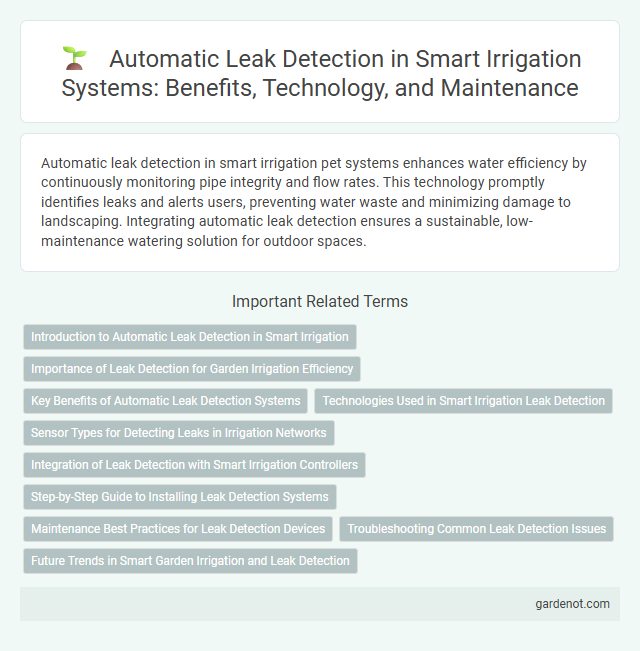Automatic leak detection in smart irrigation pet systems enhances water efficiency by continuously monitoring pipe integrity and flow rates. This technology promptly identifies leaks and alerts users, preventing water waste and minimizing damage to landscaping. Integrating automatic leak detection ensures a sustainable, low-maintenance watering solution for outdoor spaces.
Introduction to Automatic Leak Detection in Smart Irrigation
Automatic leak detection in smart irrigation leverages advanced sensors and real-time data analytics to identify water leaks swiftly and accurately, minimizing water waste and preventing damage. These systems use soil moisture sensors, flow meters, and pressure monitors integrated with IoT technology to detect anomalies in water distribution patterns. Early detection through automated monitoring enhances system efficiency, promoting sustainable water management in agricultural and landscaping applications.
Importance of Leak Detection for Garden Irrigation Efficiency
Automatic leak detection in smart irrigation systems significantly enhances garden irrigation efficiency by preventing water loss and ensuring optimal water distribution. Early identification of leaks reduces water waste, lowers utility costs, and protects plants from overwatering damage. Integrating sensors and real-time monitoring enables precise maintenance, promoting sustainable water use and healthier garden ecosystems.
Key Benefits of Automatic Leak Detection Systems
Automatic leak detection systems in smart irrigation significantly reduce water wastage by identifying leaks in real-time, ensuring efficient resource management. These systems enhance the longevity of irrigation infrastructure by preventing damage caused by undetected leaks, leading to lower maintenance costs. Improved crop health and yield result from consistent water delivery, driven by precise leak detection and timely repairs.
Technologies Used in Smart Irrigation Leak Detection
Smart irrigation leak detection leverages advanced sensor technology such as soil moisture sensors, flow meters, and pressure sensors to monitor water distribution precisely. IoT-enabled systems integrate real-time data analytics and machine learning algorithms to identify anomalies indicating leaks early in irrigation networks. Ultrasonic and acoustic sensors are increasingly employed to detect pipe ruptures and leaks, minimizing water waste and optimizing irrigation efficiency.
Sensor Types for Detecting Leaks in Irrigation Networks
Automatic leak detection in smart irrigation systems relies heavily on advanced sensor types such as soil moisture sensors, flow sensors, and pressure sensors. Soil moisture sensors detect abnormal moisture levels indicating potential leaks, while flow sensors monitor water volume inconsistencies to identify leak points. Pressure sensors track drops or fluctuations in irrigation network pressure, enabling precise leak localization and efficient water conservation.
Integration of Leak Detection with Smart Irrigation Controllers
Integrating automatic leak detection with smart irrigation controllers enhances water conservation by identifying leaks in real time and immediately adjusting watering schedules. Advanced sensors communicate seamlessly with controllers to shut off or reduce water flow when abnormal pressure or moisture levels are detected. This integration ensures efficient water use, reduces wastage, and lowers operational costs in landscape and agricultural irrigation systems.
Step-by-Step Guide to Installing Leak Detection Systems
Installing automatic leak detection systems in smart irrigation begins with assessing the entire irrigation layout to identify critical points for sensor placement, such as valves, mainlines, and sprinkler heads. Next, install moisture and flow sensors at these precise locations, ensuring they are securely connected to a central control unit capable of real-time data processing. Finally, configure the system's software to send instant alerts and trigger automatic shutoff mechanisms upon detecting abnormal water flow, optimizing water conservation and preventing costly damages.
Maintenance Best Practices for Leak Detection Devices
Regular calibration and inspection of automatic leak detection devices ensure precise identification of water leaks within smart irrigation systems. Implementing firmware updates and sensor cleaning routines maintains device accuracy and extends operational lifespan. Using real-time data analytics enhances early leak detection, minimizing water waste and reducing maintenance costs.
Troubleshooting Common Leak Detection Issues
Automatic leak detection systems in smart irrigation often face challenges like false alarms caused by sensor malfunctions or environmental factors such as soil moisture variability. Troubleshooting requires calibrating sensors to specific soil types and regularly inspecting pipeline joints and valves for wear or damage. Implementing real-time analytics helps distinguish between normal water usage and actual leaks, reducing unnecessary water waste and maintenance costs.
Future Trends in Smart Garden Irrigation and Leak Detection
Future trends in smart garden irrigation emphasize AI-driven automatic leak detection systems that leverage machine learning algorithms to predict and identify leaks with high accuracy. Integration of IoT sensors and real-time data analytics facilitates proactive maintenance, reducing water waste and enhancing irrigation efficiency. Advances in edge computing enable localized processing, minimizing latency and improving the responsiveness of smart irrigation networks.
Automatic leak detection Infographic

 gardenot.com
gardenot.com